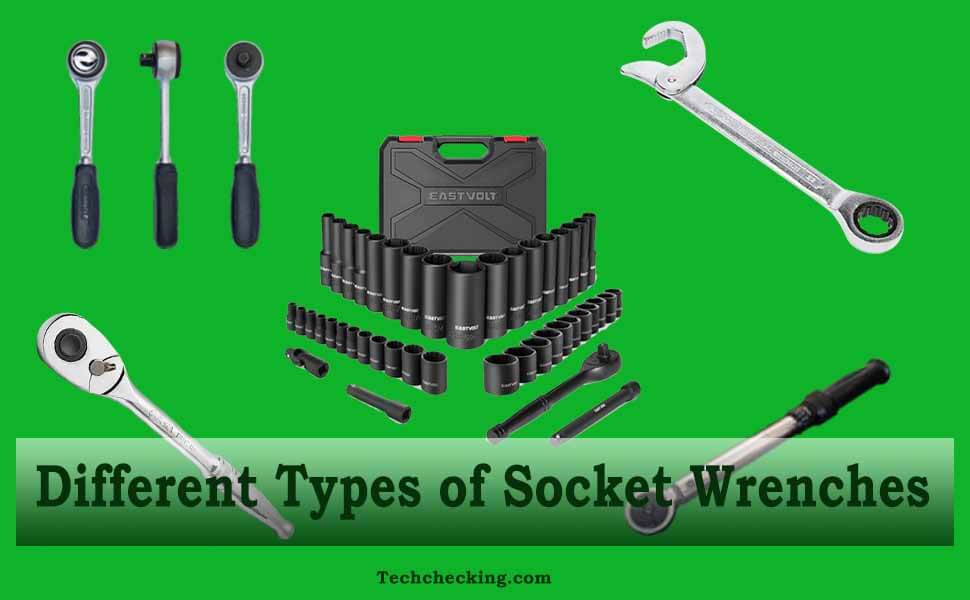Socket wrenches are essential tools to tighten or loosen fasteners easily. These invaluable tools are used for installing and removing nuts or bolts with a hexagonal head. In fact, socket wrenches provide a superior level of torque if compared to standard wrenches. There are different types of socket wrenches out in the market though each of them has a different method of operation. You need to know its use as well. So, if you are starting to think about what are the different types of socket wrenches, here we are. Before jumping to know the different types of socket wrenches, we should know about what is a socket wrench. In this article, we are covering different types of socket wrenches. You will have a clear idea after reading this.
What Is A Socket Wrench?
A socket wrench, also known as a spanner, is a hand tool that is used for tightening bolts and nuts. It uses a closed socket instead of a typical open wrench or spanner. The most common form of a ratcheting socket wrench is ratchet. A ratchet having a reversible ratcheting mechanism allows the users to pivot the tool back and forth to turn its socket, unlike adjustable wrenches. A handle equipped with a mechanism of a socket-wrench set measures the amount of torque that is exerted by the wrench on the nut or bolt. The purpose of a socket wrench is to make sure that the nuts and bolts are assembled or installed well without being overtightened or to prevent loosening during use.
Related Articles
Different Types of Socket Wrenches
If you are going to fix your vehicles such as motorcycle, car, truck, or others, you must need different types of socket wrenches to tighten or loosen the fasteners. Here we will discuss those types of socket wrenches. However, we will try to show here 5 types of socket wrenches with images so that you can easily understand them. Let’s get started with the different types of socket wrenches.
Fixed Socket
Interchangeable Socket
-Ratcheting
-Non-ratcheting
Powered Socket
These are the types of socket wrenches. We will eventually discuss them one by one. Let’s walk together.
Fixed Socket Wrenches
Fixed socket wrenches are those types of sockets that are fixed with no additional heads. The handle with its head is fixed and is in no way interchangeable. Let’s now see different types of fixed socket wrenches.
Lug Wrench
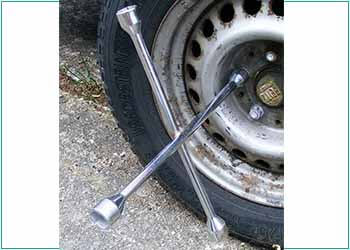
A lug wrench is a kind of non-ratcheting socket wrench. It is permanently attached to the end of an L-shaped, or X-shaped bar. Lug wrenches are designed especially for socket wrenches. It is mostly used for loosening and tightening lug nuts on automobile or truck wheels. In the United Kingdom and Australia, it is commonly known as a ‘wheel brace’.
Nut Driver
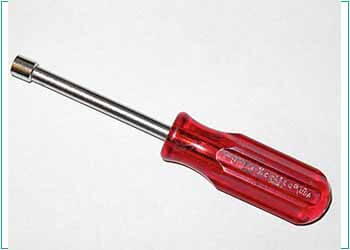
A nut driver is a screwdriver-type hand tool. Except for the head, there is no difference between a nut driver and a screwdriver. It has a hand-turning handle with a built-in female socket at the end of either metric or fractional-inch sizes. Nut drivers come in different sizes and lengths. A nut driver is a hand tool used for tightening nuts and bolts. In addition, a nut driver consists of a socket attached to a shaft and a cylindrical handle. And, they generally have a hollow shaft to accommodate a shank onto which a nut is threaded.
Flex-head Socket Wrench
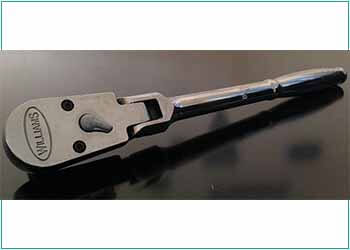
The flex-head socket wrench is similar to a socket wrench. It is called a Saltus wrench too. A Saltus wrench has a socket permanently affixed to a handle. Since the sockets are fixed to a handle, they are not interchangeable with a socket wrench. However, the sockets rotate around the handle in order to access a fastener from different angles. Generally, a Saltus wrench features a double-ended wrench. One of the sides is an open-end type head while the other side is from the socket head.
T-handle
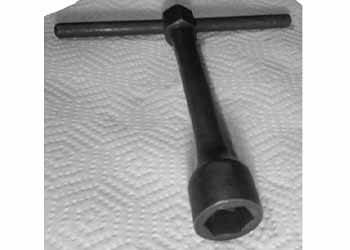
A kind of socket attached to a T-handle that is used for leverage. The socket may be fixed or sliding. Most times the sockets are sliding for handy use. If the socket is sliding, you can adjust by extending one side bigger or shorter.
Tuning Wrench
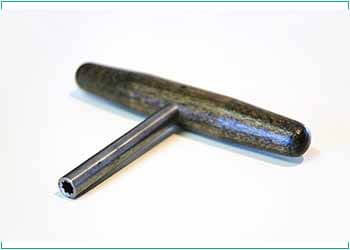
This wrench is a tuning “T” hammer piano tuning lever. It is used to tune some stringed musical instruments. A tuning wrench, in some cases, is identical to drum tuning keys. However, it provides greater torque due to the higher tension of strings. A very essential tool for fixing musical instruments.
Tube Spanner
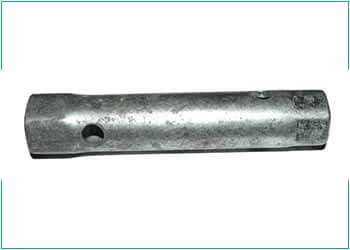
A tube spanner, also called a spark plug wrench, looks like a tube that has six-sided sockets on both ends. To use this tube spanner, a short length of rod (Tommy bar or T-bar) is required. A T-bar-like rod is inserted through two holes in the middle of the tube. The two sides (ends) are like a box, this is why a tube spanner is also called a box spanner. This box spanner is used in such situations where a common-sized fastener is recessed deep in a blind hole with minimal radial clearances.
Interchangeable Sockets
Interchangeable sockets are often interchangeable. This helps fit nuts or bolts according to your need. They can be adjusted too. There are two types of interchangeable sockets that we will discuss – Ratcheting and Non-ratcheting. Let’s get started.
Ratcheting
Ratcheting Socket Wrench
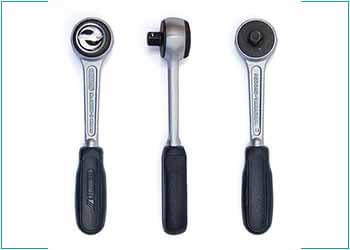
Ratcheting socket wrenches are the most common type of socket wrenches. The ratcheting mechanism helps tighten or loosen a nut or bolt with a reciprocating motion. A small lever on the ratchet head switches the wrench between tightening and loosening modes. These drive fittings come in four common sizes. They are – 1⁄4 inch, 3⁄8 inch, 1⁄2 inch, and 3⁄4 inch (referred to as “drives”, as in “3⁄8 drive”). Manufacturers produce wrenches to 6.3 mm, 9.5 mm, 12.5 mm, and 19 mm. a ratchet socket wrench is much faster than a conventional wrench, especially in repetitive bolt-on or bolt-off usage. In addition, it is much more efficient than a set of non-ratcheting wrenches, with every size head having its own handle.
In terms of teeth, a ratchet has two types of teeth. They are fine-tooth ratchets and dual-pawl ratchets. Fine-tooth ratchets have finer teeth on the ratcheting components and these are useful for tighter locations. Dual-pawl ratchets, on the other hand, click twice for each tooth on the gear.
Click-style Torque Wrench
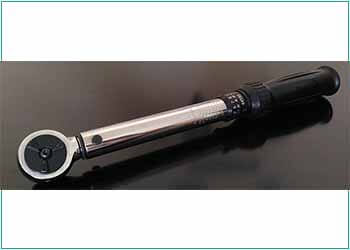
Ratcheting and clicking happen when a preset torque is reached. Some torque wrenches have digital read-outs of torque. And other types of torque wrenches have preset torque. A preset torque is required so that they don’t slip before reaching a certain level. However, in some fields, torque devices are used with a torque wrench.
Flex-head Ratchet
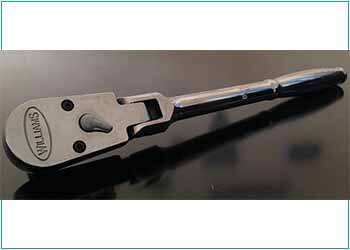
A flex-head ratchet is a kind of ratchet in which the drive head pivots or swivels back and forth. The drive head swivels on the handle to the rear of the ratchet head.
Swivel-head Ratchet
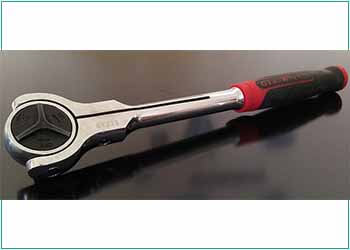
A swivel-head ratchet is also called the roto-ratchet. The head of the ratchet swivels has a handle attachment on the side of the ratcheting head. In this case, the handle is attached to the side rather than the rear of the ratcheting head. In terms of a flex head ratchet, the handle is attached to the rear of the ratchet head.
Palm Ratchet
A palm ratchet is a kind of ratchet that is a knurled palm-sized circular ratchet handle with a reversible socket. This type of ratchet is very useful for rapidly loosening or tightening a bolt or nut. Palm ratchets come in a variety of sizes.
Rotator Ratchet
A rotator ratchet works by twisting the ratchet handle around the handle axis. This type of ratchet requires less than a one-degree arc swing to rotate the socket. Doing this makes them good for very tight spaces.
Gearless Ratchet
The name of the ratchet describes it itself. A gearless ratchet doesn’t use gears. Instead of using gears, they use bearing to provide an audible or discernible click. Anyways, this is not commonly used as the regular geared ratchet.
Non-Ratcheting
Breaker Bar
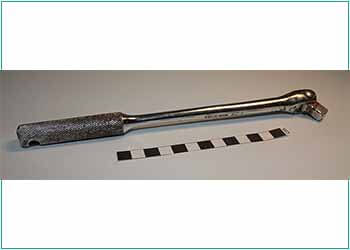
A breaker bar, also known as a power bar, is a long non-ratcheting bar that is used with socket-wrench-style sockets. Breaker bars are used to break loose very tight fasteners that are difficult to unfasten. The additional length of the handle can generate significantly more torque than a standard-length socket wrench. In addition, the breaker bar is able to avoid potential damage to the ratcheting mechanism of the socket wrench. Once you break loose the fastener, the breaker bar can be turned with a socket wrench or by hand.
Beam-style Torque Wrench
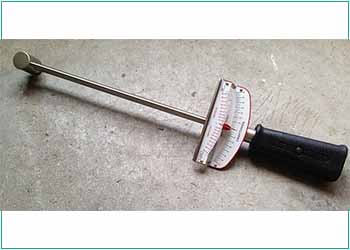
A beam-style torque wrench is a non-ratcheting tool that is made to attach to standard sockets. The applied torque can be determined by monitoring the degree of beam deflection.
Speed Handle
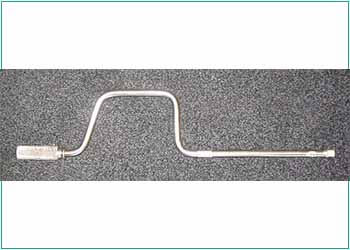
A speed handle is also called a speed brace. It is a crank-shaped handle that loosens or tightens a fastener. When doing the work, make sure that you have used the correct socket. It works much like a brace and bit adapted to sockets.
Spinner Handle
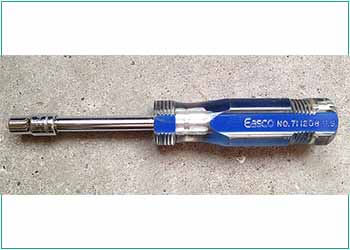
People know a spinner handle as a socket handle too. A spinner handle looks like a screwdriver handle. The only difference between a screwdriver and a spinner handle is a spinner handle has a screwdriver handle with a male drive end for attaching sockets.
Powered-Sockets
Besides fixed sockets and interchangeable sockets, powered sockets are available to loosen or tighten the nuts or bolts. They are also known as “air” (pneumatic) ratchets. They use compressed air power to drive air-powered socket wrenches to tighten or loosen nuts or bolts. If you want to use a powered tool as lug nuts on wheels, that would be impact wrenches. However, electric-powered impact wrenches are very common for those tasks as well. For example, small cordless 12-volt and 18-volt impact drivers are often used for this kind of job.
In addition, hydraulic motor ratchets with higher torque are rare outside heavy industry. The sockets we use for impact duty are generally called impact sockets. Impact sockets are made with thicker walls as well as tempered to lower hardness. One more thing, impact sockets are finished in black oxide rather than the usual chrome plating of the hand-tool variety. And yes, Standard sockets such as non-impact sockets may shatter if used with impact wrenches, presenting a safety risk.
Socket Types
Sockets are usually referred to by the number of “points”. The common designs of the pointed intersections of their multi-faceted interior sides are:
6 point or hexagon:
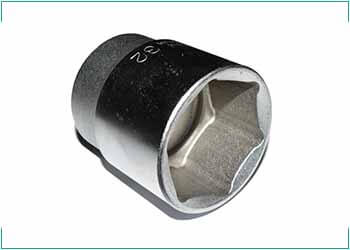
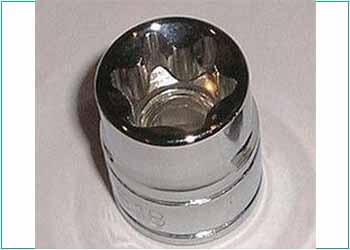
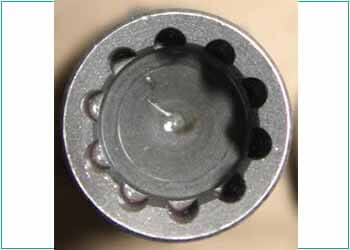
This is called 6 point because it has 6 pointed intersections and is used for hexagonal nuts. A very effective tool for fastening or unfastening nuts or bolts. There are different types of sockets such as curved (splined), 12 point (24 facets), etc.
Impact Sockets and Drivers
Impact sockets and drivers provide high torque and this is why they are made of high-quality materials. Specifically, they are constructed with thicker, tougher, and more ductile alloy steel. However, they often use CrMo steel to replace the CrV steel used in non-impact sockets. Most impact sockets made for “standard” hexagonal fasteners have a six-point design.
Sockets plated with chrome are not suitable because the impact wrench may break the chrome plating. Impact sockets use different coatings such as a black phosphate conversion coating, or black oxide. You can know more from here.
Final Words
So, what are the different types of socket wrenches? Learned something yet now? Knowing different types of socket wrenches is important. We have tried to describe different types of socket wrenches with images. It would be our pleasure if you found this article useful.

